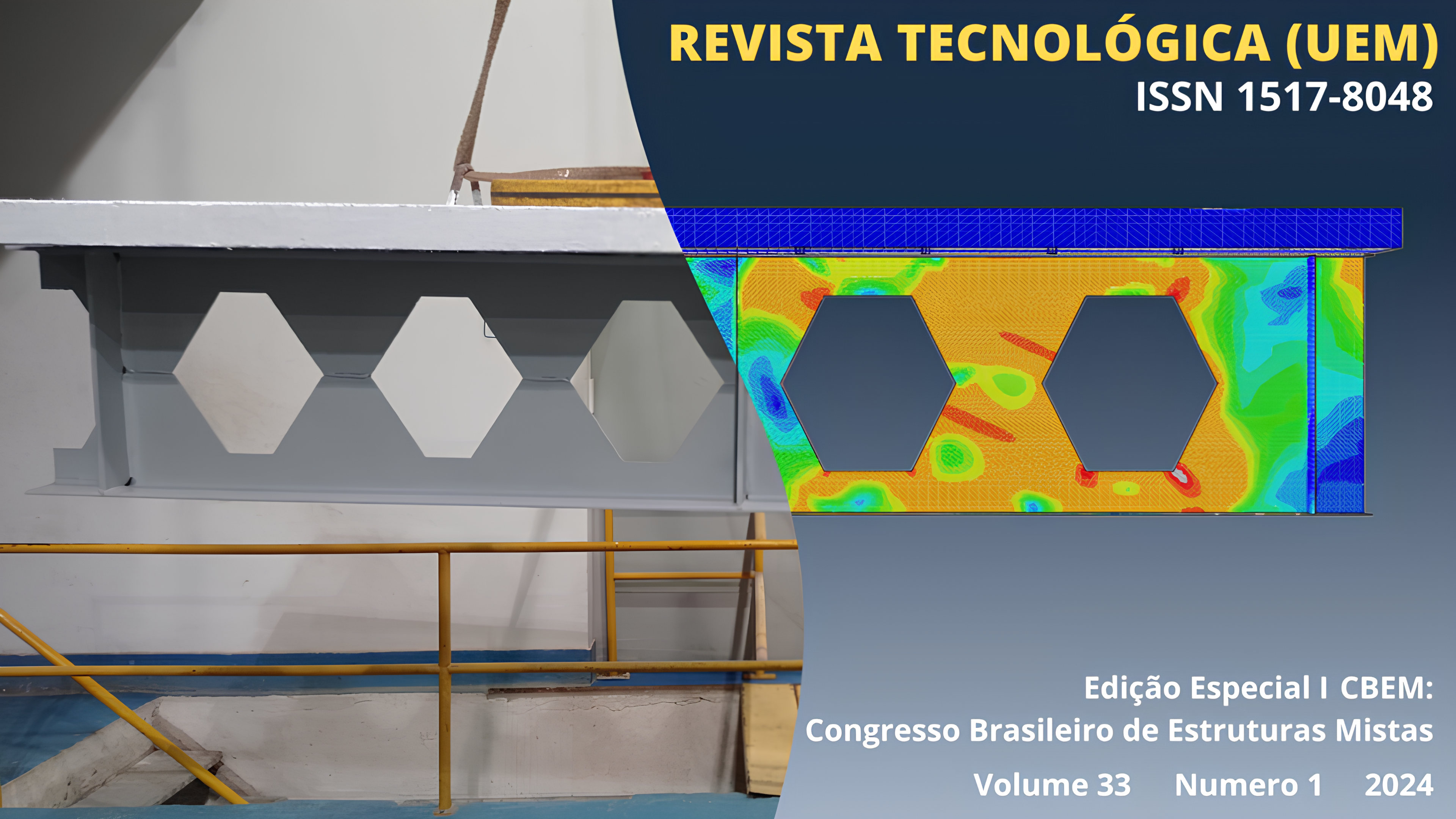DESIGN METHODS FOR RECYCLED AGGREGATE CONCRETE-FILLED STEEL TUBE (RACFST) STUB COLUMNS UNDER CONCENTRIC COMPRESSION
Abstract
The confinement of Recycled Aggregate Concrete (RAC) has become an interesting alternative for its application in structures due to its greater deformability and lower resistance. Recycled Aggregate Concrete-Filled Steel Tube (RACFST) is an economical alternative to Concrete-Filled Steel Tube (CFST), in addition to reducing environmental impact and consumption of natural resources. However, the existing recommendations refer to CFST columns, while there is currently only one design standard for RACFST columns. The aim of this study is to determine the applicability of standards and methods from the literature in RACFST column design. For this, seven standards for CFST, one for RACFST and four methods from the literature for RACFST were tested on 97 experimental results of short RACFST columns. All standards were found to be efficient in calculating the load-bearing of RACFST columns, with the RAC compressive strength being the main parameter differentiating the methods. The confinement effect is taken into account in the methods in different ways, which also affects the load-bearing capacity of the RACFST columns.
Downloads
References
AMERICAN INSTITUTE OF STEEL CONSTRUCTION. ANSI/AISC 360: Specification for Structural Steel Buildings. Chicago, 2016.
ASSOCIAÇÃO BRASILEIRA DE NORMAS TÉCNICAS. NBR 8800: Projeto de estruturas de aço e de estruturas mistas de aço e concreto de edifícios. Rio de Janeiro, 2008.
AZEVEDO, V. S. et al. Experimental investigation on recycled aggregate concrete filled steel tubular stub columns under axial compression. Journal of Constructional Steel Research, v. 187, p. 106930, 2021. https://doi.org/10.1016/j.jcsr.2021.106930
CANADIAN STANDARDS ASSOSIATION. CAN/CSA S16-09: Design of steel structures. Ontario, 2009.
CHEN, K. et al. Intelligent design of limit states for recycled aggregate concrete filled steel tubular columns. Structures, v. 58, n. October, p. 105338, 2023a. https://doi.org/10.1016/j.istruc.2023.105338
CHEN, L. et al. Axial compressive strength predictive models for recycled aggregate concrete filled circular steel tube columns using ANN, GEP, and MLR. Journal of Building Engineering, v. 77, p. 107439, 2023b. https://doi.org/10.1016/j.jobe.2023.107439
CHEN, Z. et al. Performance and calculations of recycled aggregate concrete-filled steel tubular (RACFST) short columns under axial compression. International Journal of Steel Structures, v. 14, n. 1, p. 31–42, 2014. https://doi.org/10.1007/s13296-014-1005-5
DONG, J. F.; WANG, Q. Y.; GUAN, Z. W. Material and structural response of steel tube confined recycled earthquake waste concrete subjected to axial compression. Magazine of Concrete Research, v. 68, n. 6, p. 271–282, 2016. https://doi.org/10.1680/jmacr.14.00357
EUROPEAN COMMITTEE FOR STANDARDIZATION. EUROCODE 2: Design of concrete structures - Part 1-1: General rules and rules for buildings. Brussels, 2004.
EUROPEAN COMMITTEE FOR STANDARDIZATION. EUROCODE 4: Design of composite steel and concrete structures – Part 1-1: General rules and rules for buildings. Brussels, 2004.
GB50936. GB 50936-2014: Technical code for concrete filed steel tubular structures. Beijing, 2014 (em chines).
HAN, L. H.; XU, C. Y.; HOU, C. Axial compression and bond behaviour of recycled aggregate concrete-filled stainless steel tubular stub columns. Engineering Structures, v. 262, n. May, p. 114306, 2022. https://doi.org/10.1016/j.engstruct.2022.114306
LYU, W. Q.; HAN, L. H.; HOU, C. Axial compressive behaviour and design calculations on recycled aggregate concrete-filled steel tubular (RAC-FST) stub columns. Engineering Structures, v. 241, n. May, p. 112452, 2021. https://doi.org/10.1016/j.engstruct.2021.112452
SHANMUGAM, N. E.; LAKSHMI, B. State of the art report on steel-concrete composite columns. Journal of Constructional Steel Research, v. 57, n. 10, p. 1041–1080, 2001. https://doi.org/10.1016/S0143-974X(01)00021-9
T/CECS 625. TCECS 625-2019: Technical specification for recycled aggregate concrete-filled steel tubular structures. Beijing, 2019 (em chines).
TAM, V. W. Y.; WANG, Z. BIN; TAO, Z. Behaviour of recycled aggregate concrete filled stainless steel stub columns. Materials and Structures/Materiaux et Constructions, v. 47, n. 1–2, p. 293–310, 2014. https://doi.org/10.1617/s11527-013-0061-1
WANG, E. et al. Confinement Effect and Efficiency of Concentrically Loaded RACFCST Stub Columns. Materials, v. 15, n. 1, p. 18, 2022. https://doi.org/10.3390/ma15010154
WANG, Y.; CHEN, J.; GENG, Y. Testing and analysis of axially loaded normal-strength recycled aggregate concrete filled steel tubular stub columns. Engineering Structures, v. 86, p. 192–212, 2015. https://doi.org/10.1016/j.engstruct.2015.01.007
XIAO, J. et al. Mechanical properties of confined recycled aggregate concrete under axial compression. Construction and Building Materials, v. 26, n. 1, p. 591–603, 2012. https://doi.org/10.1016/j.conbuildmat.2011.06.062
YANG, D.; LIU, F.; WANG, Y. Axial compression behaviour of rectangular recycled aggregate concrete-filled steel tubular stub columns. Journal of Constructional Steel Research, v. 201, p. 107687, 2023. https://doi.org/10.1016/j.jcsr.2022.107687
YANG, Y. F.; HAN, L.-H.; MAN, L. H. Compressive and flexural behaviour of recycled aggregate concrete filled steel tubes (RACFST) under short-term loadings. Steel and Composite Structures, v. 6, n. 3, p. 257–284, 2006.
ZHANG, W. H. et al. Axial-load response of CFST stub columns with external stainless steel and recycled aggregate concrete: Testing, mechanism analysis and design. Engineering Structures, v. 256, p. 113968, 2022. https://doi.org/10.1016/j.engstruct.2022.113968
ZHAO, H. et al. Performance of recycled aggregate concrete-filled high-strength steel tubes under axial compression , tension and torsion. Thin-Walled Structures, v. 184, p. 110478, 2023. https://doi.org/10.1016/j.tws.2022.110478
Os autores podem manter os direitos autorais pelo seu trabalho, mas repassam direitos de primeira publicação à revista. A revista poderá usar o trabalho para fins não-comerciais, incluindo direito de enviar o trabalho em bases de dados de Acesso Livre.










